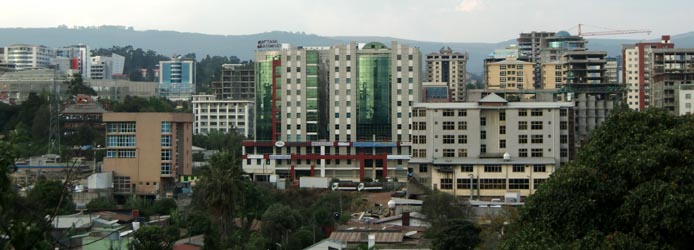About Ethiopia
| Shortcut | |
| Ethiopia is a democratic country with a multiethnic and multilingual society. It has a rich
cultural and religious history (with 9 UNESCO World Heritage Sites). Its landscape and wildlife are fascinating and the customs of the traditionally living tribes of the south
are breathtaking. The climate goes from moderate to really extreme. |
|
| Population | |
| Inhabitants | 88 million (estimated); increase of population: 2,5 % |
| Demographics | 45 % of population up to 14 years, 52 % 15-64 years, 3 % over 65 years |
| Ethnic groups | 34 % Oromo, 27 % Amhara, 6 % Somali, 6 % Tigray, 4 % Sidama, 2 % Welayta, 2 % Afar ... |
| Religion | 43 % Ethiopian-Orthodox, 34 % Moslems, 18 % Protestants, 3 % Natural Religions ... |
| Languages | Amharic (official language); English (commercial language) 83 different spoken languages in Ethiopia: Oromo 34 %, Somali 6 %, Tigrinya 6 % ... |
| Urbanization | 16% urban, 84% rural |
| Area | 1,104,300 km2; 80 inhabitants / km2 |
| Largest cities | Addis Ababa, Mekele, Adama, Dire Dawa, Gondar, Awassa, Bahir Dar, Jimma, Dessie ... |
| Health | |
| Infant Mortality Rate | 70 out of 1,000 births |
| Life Expectancy | 58 years (male) and 62 years (female) |
| Physicians Density | 3 / 100,000 inhabitants |
| HIV / Aids | 2 % (2006/07) |
| Education | |
| Alphabetisation | men 50 %, women 23 % (UNDP, 2005); average 42 % (2012) |
| School | Primary school: 102 % (brutto), secondary school: 42 % (2012) |
| Climate | |
| Climes | Climate varies according to 3 different topographical regions: Tropical zone (Qolla) below 1,800 m: hot (desert) to tropical-humid (lowlands) average annual maximum temperature 27°C, annual rainfall about 500 mm Subtropical zone (Woyna dega) 1,800 - 2,500 m: moderate average annual maximum temperature 22°C, annual rainfall 750 - 1,000 mm Cool zone (Dega) above 2,500 m: cool average annual maximum temperature 16°C, annual rainfall up to 1,800 mm |
| Rainy Period | In the highlands from June to September (March to April) |
| Elevation | From 116 m below (Danakil Depression) to 4,550 m above sea level (Ras Dashen) |
| Time | |
| Ethiopian Calender | 7 years and 8 months behind Western (Gregorian) Calendar; 2007 ⇒ 2000 A year lasts 13 months, New Year's Day is on September 11th or 12th |
| Time of Day | Cycle from 1 to 12 o'clock, which means from dawn to dusk. Day starts at 7 o'clock East Afrika Time which is 1 o'clock Ethiopian time |
| Holidays | Ethiopian Christmas 01-07, Timkat 01-19, Victory at Adwa Day 03-02, Good Friday and Easter (movable), Labour Day 05-01, Patriots' Victory Day 05-05, Derg Downfall Day (National holiday) 05-28, New Year's Day 09-11, Meskel 09-29 |
| Traffic | |
| International Airport | Addis Ababa Bole International Airport |
| National Airports | In all bigger cities: Mekele, Dire Dawa, Gondar, Awassa, Bahir Dar ... |
| Trains | No regular service, railway system under construction |
| Transportation | Minibus, taxi and bus |
| Economics | |
| Currency | Ethiopian Birr (ETB) 1 Euro = 23,97 ETB; 100 ETB = 4,17 Euro (2013, March) |
| Gross Domestic Product | 515 USD / per capita and year (2012) |
| Politics | |
| Government | Federal Parliamentary Republic |
| Administation Structure | 9 regions with 2 cities of administration (Addis Ababa und Dire Dawa) |
| Politicians | Prime Minister: Hailemariam Desalegn President: Girma Wolde-Giorgis |
| Parties | Ethiopian People's Revolutionary Democratic Front (EPRDF, a coaltion of TPLF, ANDM, OPDO and SEPDM) |
| Addis Ababa, Capital City | |
| Population | 4 Mio inhabitants; 7,500 inhabitants / km2 |
| City | 527 km2 |
| Elevation | 2,355 m; Mount Entoto: 3,200 m |






